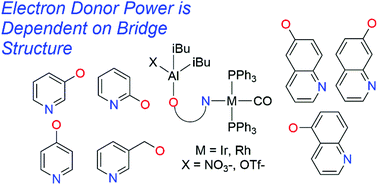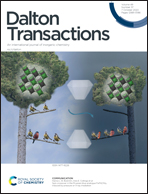Systematic evaluation of the electronic effect of aluminum-containing ligands in iridium–aluminum and rhodium–aluminum bimetallic complexes†
Abstract
Pyridinemethanolate and oxyquinoline derivatives of previously reported late transition metal–aluminum heterobimetallic complexes containing iridium and rhodium have been synthesized and characterized. A combination of experimental and computational data permits a direct comparison of the electronic effects of each novel aluminum-containing ligand in our library on the late transition metal centers. Alongside electronic data of previously reported oxypyridine bridged systems, we conclude that the addition of a dialkylaluminum(X) (X = anion) fragment does not significantly perturb the electron donor ability of the bridging ligand. Anions bound to the aluminum are also shown to behave similarly. The overall library, thus, suggests that the best predictor of the electron donor ability of an alkylaluminum-containing ligand to a transition metal is the donor power of the bridging ligand.



 Please wait while we load your content...
Please wait while we load your content...